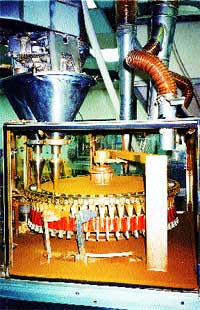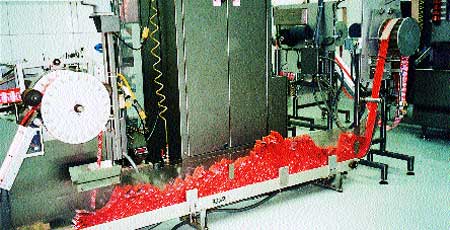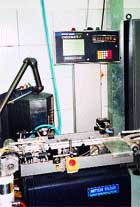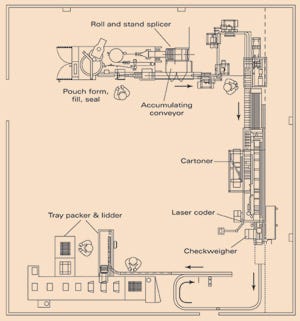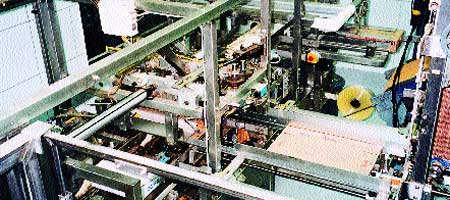New continuous-motion cartoner improves output
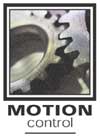
CPR International packages a line of seasonings in 5- and 10-g pouches for Goya Foods, Inc., the largest Hispanic food company in the U.S.
Goya Foods, Inc., was founded in 1936 in New York by Spanish immigrants Prudencio and Carolina Unanue, who began importing authentic Spanish products such as olives, olive oil and sardines, and selling them to New York's growing Hispanic population. More than 65 years later, Goya has become America's premiere purveyor of rice, beans, seasonings, nectars and authentic Latin specialties. Goya products are distributed from coast to coast and beyond, to customers from all backgrounds who seek great-tasting, quality food products.
CPR installed the first new high-speed line for the seasonings in '93, and has installed four more lines over the past seven years to meet customer demand. Last year, it doubled the speed of the Cloud LLC filler on the initial line, added some pouch-handling equipment after the filler and replaced an intermittent-motion Klöckner Bartelt cartoner with a new servo-driven continuous-motion Klöckner Bartelt cartoner to keep up with the filler.
|
Continuous-motion cartoner, above left, replaced previous intermittent-motion unit to keep up with doubled output from filler. Barrel-loader pusher-arms, above right, insert pouches into the open ends of the cartons. |
"We have Klöckner equipment, and we have a great relationship with them, so they were the first company we called when we decided to upgrade production here in Miami," says CPR general manager Frank Unanue.
Cartoner features six servo drives
This line runs cartons containing eight and 12 pouches at speeds of 1,100 and 1,300 pouches/min, respectively. The new Klöckner Bartelt cartoner has six Indramat servo drives (now part of Bosch Rexroth, which acquired Indramat a year ago): the main carton feed, the infeed bucket conveyor and barrel loader assembly, two on the minor flap closers (one on each side), and two on the carton flight chains (each side). "These servos replace more than half of the mechanical parts from mechanical cartoners and have a position accuracy of 32,000 to one, so they provide exceptional reliability and precision," says Klöckner Bartelt regional sales manager David Houmes.
The continuous bandoleer of pouches from a horizontal Cloud pouch machine is cut into pairs, with a perforation between the two pouches in each pair by the Cloud knife. Pairs of pouches are formed into stacks directly in the cartoner buckets passing continuously beneath. In this operation, the first pouch hits the front of the bucket, while the last pouch hits the end of the bucket. The buckets then pass beneath a rotating conditioning wheel that presses the pouches to more evenly distribute the product to yield a consistent stack for cartoning.
Prior to loading, vacuum cups on rotating arms pick individual cartons out of the carton magazine, open the cartons, and place them in the carton flight conveyor. A servo-driven flap closer tucks the minor flaps on the non-load side, after which barrel-loader pusher-arms insert the pouches into the open end of the moving carton. The cartons are then conveyed past the minor flap closer on the load side, after which the major flaps are finally closed and sealed by a Nordson Model 3400V hot-melt unit.
Cartons are supplied by Malnove, Inc. of Florida, which has worked extensively with CPR and Klöckner Bartelt to redesign and improve the cartons since the first powder line was installed in Miami. Changes have included reducing the weight of the carton material, changing carton dies, and making structural design changes, all of which helped improve line efficiency from 60 percent to the high 90-percent range.
Rotary powder filler runs up to 1,300 pouches/min
To start the packaging operation, pouches are formed and filled by a rotary poucher from Cloud LLC. The unit is equipped with a PK Series automatic web splicer from Keene Technology, Inc. Two rolls of film are mounted vertically on this splicing unwind unit, one above the other. The unwinding roll passes through a 6-ft-high storage festoon, where it makes several vertical passes over rollers, before it travels to the pouch machine. Prior to a splice, the top idler rollers in the festoon move upward to create more storage.
When a splice is performed, the festoon idler rollers are lowered so that the stored film allows the pouch machine to keep running. During this time, the trailing edge of the expiring roll is automatically taped to the leading edge of the new roll. As the film is dispensed from the splicer, the rollers rise to restore the film reserve. After leaving the splicer, the film passes through an alignment inspection and alignment system from Fife Corp. Mounted on the infeed of the pouch machine, this system moves a series of rollers slightly to shift the film to maintain alignment.
The film for the pouches, a lamination of clay-coated paper/low-density polypropylene/foil/low-density polyethylene, is supplied by several companies, one of which is Prime Graphics, Inc.
|
Dual servo-driven augers on high-speed rotary filler discharge product into 48 funnels feeding open-top pouches carried by revolving drum. |
From the alignment rollers, the film travels over a plow that folds it at the bottom. The web then travels past a horizontal rotary-sealing drum that has vertical sealing bars that create the vertical seals. As the film leaves this drum, it passes through a bottom-sealing section. This bottom seal is not actually required, but it results in a nicer-looking pouch.
CPR runs several different powdered seasonings on the line, including Sazon Goya, salad, and ham. The seasoning is mixed in another room, and is delivered to the filling room in a large bin. It is then transported by an inclined screw conveyor from Flexicon Corp. to the overhead hopper of the auger filler unit, which was supplied by Klöckner Bartelt. The Cloud filler wheel consists of a large revolving drum that carries the open-top pouches past two parallel, dual-discharging, servo-driven auger fillers.
On the filler wheel, pouches are blown wide open with an air knife. The filler plate is tipped slightly toward the filling section, so that the funnels are lower at this point and penetrate slightly into the pouches during filling.The outer edge of the top of the filler plate consists of 48 chambers separated by knife-edge partitions. Each chamber has a funnel bottom that actually delivers the powder into the open pouch waiting beneath. Both the filler wheel and the augers run continuously, and the volume dispensed into each pouch is adjusted by changing the speed of the augers relative to the speed of the pouch machine. A suction tube removes any powder that builds up on the partitions to help optimize accuracy.
|
The continuous web of sealed pouches drops into a long conveyor that provides an accumulating section in case of downstream operating problems. |
The continuous web of pouches leaving the filler passes between two horizontal rollers that seal the tops, and then goes over a wheel that deposits it into a long Cloud Cumulus conveyor that provides an accumulating section in case of downstream operating problems. The bandoleer of pouches then moves over a series of flighted wheels that change the direction of the web 90 degrees before it enters the pouch cutoff machine.
On its way into the Cloud Remote Knife, the pouches are conditioned for flatness. The web also passes an inspection station where a probe checks for empty pouches, and an electric eye watches for the tape that spliced the rolls together. If either of these is detected, those pouches, along with adjacent pouches, will be rejected after they are separated.
|
In addition to monitoring weights of pouches, checkweigher incorporates a closed-loop feedback option that adjusts the speed of the augers on the filler to deliver the proper weight of product into the pouches. |
In the knife, the bandoleer passes over the major hub that carries it past an adjacent cutting wheel. This wheel actually has alternating cutting and perforating blades that cut the web into tandem pouches (two-pouch segments connected by a perforated section of film). To maintain control, the separated pairs are gripped by the suction cups on the major hub, and these cups deliver the pairs to suction cups on the transfer wheel.This wheel creates stacks of pouches in the buckets of the Klöckner Bartelt cartoner as described previously.
Packer loads cartons on tray, applies lid
As the cartons leave the cartoner, a code containing line number, shift and date is applied by a Xymark laser printer from Linx Technologies, Inc. (formerly GSI Lumonics). The cartons then pass over a Checkmate 2 checkweigher from Hi-Speed Checkweigher. In addition to monitoring cartons with an accuracy of ?1 g, the checkweigher incorporates a closed-loop feedback option that adjusts the speed of the augers on the filler to deliver the proper weight of powder into the pouches. At CPR, the checkweigher collects weight data continuously, from up to 150 cartons, and continuously corrects the filler settings to optimize the process.
|
Floor plan displays layout of equipment in packaging line. |
After checkweighing, the cartons travel around a conveyor loop, and nine cartons at a time are pushed onto the conveyor feeding the tray packer, which, along with a top placement unit, was supplied by Schneider Packaging Equipment. This machine loads the cartons onto a tray, and then applies a lid to the tray.
As cartons enter the machine, three of them are stood on-edge at a time and are pushed into loading lanes. When eight lanes containing 24 cartons have been assembled, the cartons are pushed onto the tray blank, which has the flaps on the far end already formed. The flaps on the loading end are formed and glued after the cartons are loaded.
|
Tray packer/lidder forms tray and loads 24 cartons. It then pushes the loaded tray up into the top blank to form the lid. |
The sides of the tray are sloped toward the front, so when the top is removed in the store, consumers can see the cartons. The tray is then turned 90 degrees, and pushed into the next section, where it is pushed up into the flat lid, dispensed from a magazine. The sides of the top are pushed down around the tray, and are glued by a Nordson Corp. Model 2304 hot-melt unit. As the tray discharges, tape is applied to secure the lid.
More information is available:
Cartoner, auger fillers: Klöckner Bartelt, Inc., 941/359-4000. Circle No. 235.
Indramat servo drives: Bosch Rexroth Corp., 847/645-3600. Circle No. 236.
Hot-melt glue systems: Nordson Corp., 770/497-3715. Circle No. 237.
Cartons: Malnove Inc. of Florida, 904/757-5030. Circle No. 238.
Pouch machine: Cloud LLC, 847/390-9410. Circle No. 239.
Roll stand and splicer: Keene Technology, 815/624-8989. Circle No. 240.
Alignment inspector: Fife Corp., 800/639-3433. Circle No. 241.
Auger conveyor: Flexicon Corp., 908/8594700. Circle No. 242.
Film: Prime Graphics, Inc., 630/227-1300. Circle No. 243.
Laser coder: Linx Technologies, Ltd., 866/244-5469. Circle No. 244.
Checkweigher: Hi Speed Checkweigher, 800/836-0836. Circle No. 245.
Tray packer/lidder: Schneider Packaging Equipment Co., Inc., 315/676-3035. Circle No. 246.
Control systems for automated machinery |
Precision equals speed in continuous-motion cartoners, and Bosch Rexroth servo drives are having a dramatic impact on cartoner applications. Rexroth Indramat has been a supplier of these servo drives, but on June 1, 2001, Bosch Automation Technology and Rexroth merged to become Bosch Rexroth Corporation. Rexroth Indramat is now part of the Electric Drives and Controls Division of the new Bosch Rexroth Corporation, a wholly owned corporation of the $27 billion Robert Bosch organization. Rexroth's open approach covers the full power and performance range of packaging machinery motion control, from 100 watt EcoDrives to 35 kW vector drives, and from 40-axis motion controllers to single-axis positioning drives. The VisualMotion? graphical user interface and programming environment runs under Windows™ operating systems. |
About the Author(s)
You May Also Like

